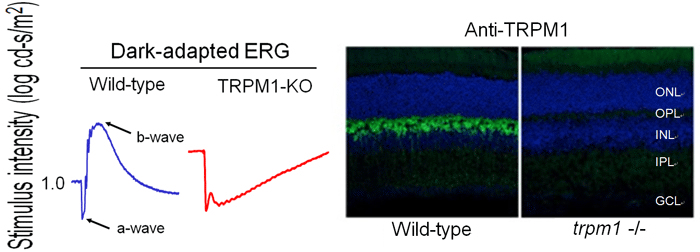TRPM1, a causative molecule for night blindness
|
The transient receptor potential cation channel, subfamily M, member 1 (Trpm1) was originally identified as a highly expressed gene in mouse metastatic melanoma cells. Trpm1 is alternatively spliced as a shortened N-terminus form (Trmp1s), known as melastatin, and a long form (Trmp1l). Recent studies indicated important roles for Trmp1l in the function of retinal bipolar cells (BCs); however, the distinct physiological and biological functions of Trpm1, especially Trpm1l, remain unclear. To address this issue, Trpm1, -knockout mice (129Sv/Ev) were generated and analyzed to clarify the role of TRMP1-L in retinal photoresponses [1]. Immunohistochemical and electrophysiological analyses of retinal tissues clearly demonstrated that TRPM1-L was a component of the transduction cation channel in the mGluR6 cascade of retinal ON BCs. These knockout mouse studies led to the investigation of human clinical cases and the successful identification of 5 different TRPM1 mutations in congenital stationary night blindness patients [2]. Human TRPM1 is also reported to be one of autoantigens targeted by autoantibodies in some cancer or melanoma patients exhibiting ON-BC dysfunction [3]. The Trpm1 -knockout mice are useful to study retinal photo-signal transduction and human congenital night blindness.
| Depositor | : | Dr. Takahisa Furukawa, Osaka Bioscience Institute | |
| References | : | [1] | Koike C, Obara T, Uriu Y, Numata T, Sanuki R, Miyata K, Koyasu T, Ueno S, Funabiki K, Tani A, Ueda H, Kondo M, Mori Y, Tachibana M, Furukawa T. TRPM1 is a component of the retinal ON bipolar cell transduction channel in the mGluR6 cascade. Proc Natl Acad Sci USA;107(1):332-7, 2010. |
| [2] | Nakamura M, Sanuki R, Yasuma T R, Onishi A, Nishiguchi K M, Koike C, Kadowaki M, Kondo M, Miyake Y, Furukawa T. TRPM1 mutations are associated with the complete form of congenital stationary night blindness. Molecular Vision;16:425-437, 2010. | ||
| [3] | Kondo M, Sanuki R, Ueno S, Nishizawa Y, Hashimoto N, Ohguro H, Yamamoto S, Machida S, Terasaki H, Adamus G, Furukawa T. Identification of autoantibodies against TRPM1 in patients with paraneoplastic retinopathy associated with ON bipolar cell dysfunction. PLoS ONE;6:e19911, 2011. | ||






